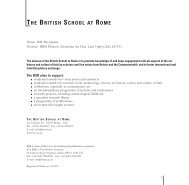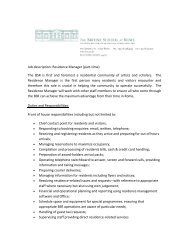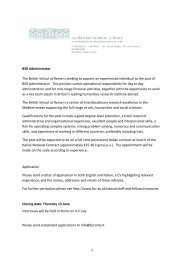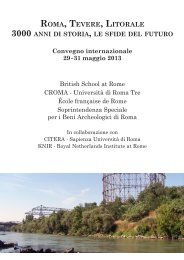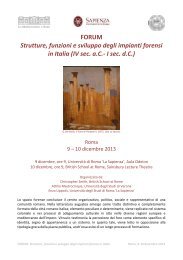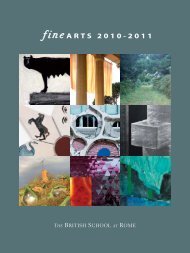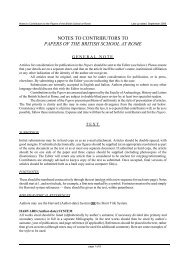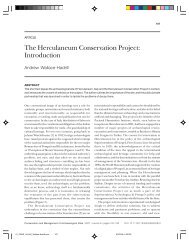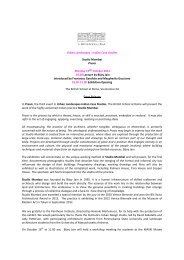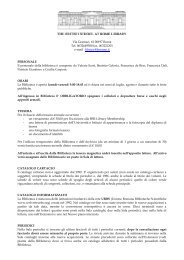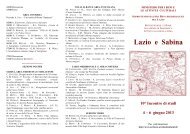Here - The British School at Rome
Here - The British School at Rome
Here - The British School at Rome
- No tags were found...
You also want an ePaper? Increase the reach of your titles
YUMPU automatically turns print PDFs into web optimized ePapers that Google loves.
Notes for Contributors to Papers of the <strong>British</strong> <strong>School</strong> <strong>at</strong> <strong>Rome</strong> Last upd<strong>at</strong>ed: December 2012NOTES FOR CONTRIBUTORS TOPAPERS OF THE BRITISH SCHOOL AT ROMEPapers of the <strong>British</strong> <strong>School</strong> <strong>at</strong> <strong>Rome</strong> exists to publish work rel<strong>at</strong>ed to the archaeology, historyand liter<strong>at</strong>ure of Italy and other parts of the Mediterranean area up to modern times, both by thestaff of the BSR and its present and former members, and by members of the academic communityengaged in top-quality research in any of these fields. Contributions are expected to be writtenin such a way as to be intelligible and appeal to the broad interdisciplinary readership of thejournal, while also presenting original, cutting-edge research in the individual specialist fields.From volume 79 (2011) Papers of the <strong>British</strong> <strong>School</strong> <strong>at</strong> <strong>Rome</strong> has been published by CambridgeUniversity Press, simultaneously in print and on-line. However, the <strong>British</strong> <strong>School</strong> <strong>at</strong> <strong>Rome</strong>retains editorial control, and your main points of contact will be the PBSR Editor and the BSR’sPublic<strong>at</strong>ions Manager. Intending authors may wish to consult the Editor in advance about thesuitability of potential submissions.EditorDr Mark Bradley, Department of Classics, University of Nottingham, University Park, Nottingham, NG72RD, UK; Mark.Bradley@nottingham.ac.ukPublic<strong>at</strong>ions ManagerDr Gill Clark, <strong>The</strong> <strong>British</strong> <strong>School</strong> <strong>at</strong> <strong>Rome</strong>, <strong>at</strong> <strong>The</strong> <strong>British</strong> Academy, 10 Carlton House Terrace, London,SW1Y 5AH, UK; bsr@britac.ac.uk; tel. (020) 7969 5202; fax. (020) 7969 5401.I N I T I A L S U B M I S S I O N F O R C O N S I D E R A T I O NArticles for consider<strong>at</strong>ion for public<strong>at</strong>ion in PBSR should be sent to the Editor. Please ensure th<strong>at</strong> your details are ona separ<strong>at</strong>e page, and th<strong>at</strong> on the article itself the author’s name, institutional affili<strong>at</strong>ion or any other indic<strong>at</strong>ion of theidentity of the author are not given.All articles must be original, and must not be under consider<strong>at</strong>ion for public<strong>at</strong>ion, or in press, elsewhere. Bysubmitting a paper to the Editor you are indic<strong>at</strong>ing th<strong>at</strong> this is the case.Submissions are normally accepted in English or Italian. Authors planning to submit in any other language shoulddiscuss this with the Editor in advance.Contributions to PBSR are assessed and approved by the Faculty of Archaeology, History and Letters of the <strong>British</strong><strong>School</strong> <strong>at</strong> <strong>Rome</strong>, and are subject to double-blind peer review by <strong>at</strong> least two specialist readers.page 1 of 9
Notes for Contributors to Papers of the <strong>British</strong> <strong>School</strong> <strong>at</strong> <strong>Rome</strong> Last upd<strong>at</strong>ed: December 2012Initial submissions normally should be sent electronically to the Editor as an e-mail <strong>at</strong>tachment (.doc or .docx, butnot a pdf), but may be sent as hard copy. Articles should be double-spaced, with good margins. It would be helpful, <strong>at</strong>this initial stage, if you also send the Editor a 100–200 word summary of the article. At this stage, if submittedelectronically, any figures should be supplied (<strong>at</strong> an appropri<strong>at</strong>e resolution) as part of the same document as the textor as <strong>at</strong> most one separ<strong>at</strong>e document. If submitted as hard copy, three copies should be supplied (including clearphotocopies of the illustr<strong>at</strong>ions). Submissions need not <strong>at</strong> this stage be fully form<strong>at</strong>ted to PBSR house style, but if thearticle is accepted it will then need to be form<strong>at</strong>ted using the guidelines below. Authors must make clear to theEditor <strong>at</strong> this stage if it is essential th<strong>at</strong> any illustr<strong>at</strong>ions are reproduced in colour in the printed volume, and of theneed for any folding plans or maps.G U I D E L I N E S F O R S U B M I S S I O N A N D H O U S E S T Y L E<strong>The</strong> diverse content of PBSR presents problems of uniformity in the style of present<strong>at</strong>ion of articles. <strong>The</strong> first priority isclarity and in some cases this may mean divergence from the standards set out below. Consistency within a paper is ofprime importance. None the less, it is expected th<strong>at</strong> contributors will, so far as is possible, follow these instructions.Expense and time will then be saved both for contributors and for the BSR.T E X TFOOTNOTES<strong>The</strong>se should be numbered consecutively through the text (and not with a new sequence for each new page). Notesshould start <strong>at</strong> 1, and not include, for example, a first note marked by a symbol. Footnotes must not be used simply forHarvard system references — these should be given in the text, within parentheses.BIBLIOGRAPHICAL REFERENCESAuthors may use the Harvard (Author-d<strong>at</strong>e) System OR the Short Title System.HARVARD (Author-d<strong>at</strong>e) SYSTEMAll works cited should be listed (alphabetically by author’s surname; if necessary divided into primary andsecondary sources) in full in a separ<strong>at</strong>e bibliography. In the text works should then be cited by author’s surname,year of public<strong>at</strong>ion, and page reference (if applicable). References should be placed in the text, r<strong>at</strong>her than given asnotes (although notes may of course be used for additional comment). <strong>Here</strong> are some examples of the style to beused.Arthur, P. (1985) Settlement and Land-use in Northern Campania during the L<strong>at</strong>e Iron Age and the Roman Period: theMassico and the Garigliano Basin. University of London, Ph.D. thesis.Barker, G. and Hodges, R. (1981) (eds) Archaeology and Italian Society (<strong>British</strong> Archaeological Reports, Intern<strong>at</strong>ionalSeries 102). Oxford, <strong>British</strong> Archaeological Reports.Brothwell, D. and Higgs, E. (1969) (eds) Science in Archaeology (second edition). London, Thames and Hudson.page 2 of 9
Notes for Contributors to Papers of the <strong>British</strong> <strong>School</strong> <strong>at</strong> <strong>Rome</strong> Last upd<strong>at</strong>ed: December 2012Herlihy, D. (1967) Medieval and Renaissance Pistoia. <strong>The</strong> Social History of an Italian Town, 1200–1430. London/NewYork, Yale University Press.Krautheimer, R. (1937–77) Corpus Basilicarum Christianarum Romae, 5 vols. V<strong>at</strong>ican City, Istituto di ArcheologiaCristiana.Plog, S., Plog, F. and Wait, W. (1978) Decision-making in modern surveys. In M.B. Schiffer (ed.), Advances inArchaeological Method and <strong>The</strong>ory I: 383–482. New York, Academic Press.Reece, R. (1982) <strong>The</strong> coins, in D. Whitehouse, G. Barker, R. Reece and D. Reese, <strong>The</strong> Schola Praeconum I: the coins,pottery, lamps and fauna: 55–6. Papers of the <strong>British</strong> <strong>School</strong> <strong>at</strong> <strong>Rome</strong> 50: 53–101 plus pl<strong>at</strong>es 3–5.Steinby, E.M. (1999) Scalae Graecae. In E.M. Steinby (ed.), Lexicon Topographicum Urbis Romae IV (P–S): 241–2.<strong>Rome</strong>, Quasar.von Falkenhausen, V. (1983) Il duc<strong>at</strong>o di Gaeta. In G. Galasso (ed.), Storia d’Italia III: 348–9. Turin, UTET.Wickham, C. (1984) <strong>The</strong> other transition: from the ancient world to feudalism. Past and Present 103: 3–36.Please note the following additional points.Multiple references to the same author and year: these should be labelled, for example, 1985a and 1985b (not 1985and 1985a).References in text should take the following forms:‘… as was noted by Smith (1967: 24) …’‘… this point has been made (Smith, 1967: 24) …’‘… as Smith (1967; 1968) has shown …’‘ … (Plog, Plog and Wait, 1978) …’‘ … (Whitehouse et al., 1982) …’Multiple references in the text to different authors: these should be given in chronological order, with the earliestfirst, for example: (Herlihy, 1967; Arthur, 1985; Herlihy, 2005).SHORT TITLE SYSTEMBooks and articles should <strong>at</strong> their first cit<strong>at</strong>ion be cited in full, with complete bibliographical details. Some examplesof the style to be used follow.P. Toubert, Les structures du L<strong>at</strong>ium médiéval. Le L<strong>at</strong>ium méridional et la Sabine du IXe siècle à la fin du XII siècle(Bibliothèque des Écoles Françaises d’Athènes et de <strong>Rome</strong> 221) (<strong>Rome</strong>, 1973), 490–502, esp. p. 495.J.F. Guiraud, ‘Le réseau de peuplement dans le duché de Gaète du Xe au XIIIe siècle’, Mélanges de l’École Française de<strong>Rome</strong>. Moyen Âge–Temps Modernes 94 (1982), 489.G. Barker and R. Hodges (eds), Archaeology and Italian Society (<strong>British</strong> Archaeological Reports, Intern<strong>at</strong>ional Series140) (Oxford, 1982).V. von Falkenhausen, ‘Il duc<strong>at</strong>o di Gaeta’, in G. Galasso (ed.), Storia d’Italia III (Turin, 1983), 348–9.page 3 of 9
Notes for Contributors to Papers of the <strong>British</strong> <strong>School</strong> <strong>at</strong> <strong>Rome</strong> Last upd<strong>at</strong>ed: December 2012R. Krautheimer, Corpus Basilicarum Christianarum Romae, 5 vols (V<strong>at</strong>ican City, 1937–77), I, 137–43.E.M. Steinby, ‘Scalae Graecae’, in E.M. Steinby (ed.), Lexicon Topographicum Urbis Romae IV (P–S) (<strong>Rome</strong>, 1999),241–2.At subsequent occurrences the reference should be shortened: for example,Toubert, Les structures du L<strong>at</strong>ium médiéval (above, n. 7), 17Guiraud, ‘Le réseau de peuplement’ (above, n. 5), 488von Falkenhausen, ‘Il duc<strong>at</strong>o di Gaeta’ (above, n. 3), 349Krautheimer, Corpus Basilicarum (above, n. 4), II, 340.Abbrevi<strong>at</strong>ions, for example for journal titles in notes, may be used if the full title appears very frequently. Whereverpossible, those given in L’Année Philologique, supplemented where necessary by those given in the American Journalof Archaeology, should be used. When an abbrevi<strong>at</strong>ion is not given there, the abbrevi<strong>at</strong>ion(s) used should be listed inthe article, usually as part of the first note.If references are very frequent, abbrevi<strong>at</strong>ions for classical authors and works may be used. <strong>The</strong>se should followthose given in the l<strong>at</strong>est edition of <strong>The</strong> Oxford Classical Dictionary.<strong>The</strong> use of ibid., idem, op. cit., art. cit., loc. cit. must be avoided.GENERALReferences in English: in book titles initial capitals should be used for all main words; in article titles initial capitalsshould be used only for proper nouns (see examples above).References in Italian: initial capital letters should be used only for proper nouns in book and article titles.References in German: initial capital letters should be used for all nouns in article titles; otherwise as for English.References in French: initial capital letters should be used only for proper nouns in book and article titles.Names of periodicals: capital letters should be used for all nouns and adjectives in all languages.Volume numbers: for periodicals, arabic figures should be used; for books in more than one volume, upper caseRoman numerals should be used. <strong>The</strong> word volume/vol. should be omitted.Page numbers: ‘p’ and ‘pp’ should be omitted unless they are absolutely essential for clarity. <strong>The</strong> exception is th<strong>at</strong> inthe short title system, where there is a specific reference within a more general reference, it should be, for example,‘37–65, esp. p. 55’.Illustr<strong>at</strong>ive m<strong>at</strong>erial: references to illustr<strong>at</strong>ive m<strong>at</strong>erial in other works should be in lower-case letters, for example,‘fig.’, ‘figs’, ‘table’, ‘tav.’ (unless to works in German, in which case there should be an initial capital).Miscellaneous m<strong>at</strong>ter such as the place of public<strong>at</strong>ion, abbrevi<strong>at</strong>ed form of editors, and ‘and’ should be given in thelanguage in which your article is written.Contributors in any doubt about the layout of bibliographical references should consult the Public<strong>at</strong>ions Manager.page 4 of 9
Notes for Contributors to Papers of the <strong>British</strong> <strong>School</strong> <strong>at</strong> <strong>Rome</strong> Last upd<strong>at</strong>ed: December 2012REFERENCES TO ACCOMPANYING ILLUSTRATIONS AND TABLESAll illustr<strong>at</strong>ions should be referred to as ‘Figures’ and will be integr<strong>at</strong>ed within the text. (See below for furtherdetails.) Reference must be made in the text to every illustr<strong>at</strong>ion. <strong>The</strong>y should be numbered according to theoccurrence of the major reference in the text. Tables should be referred to as ‘Tables’ and again numberedconsecutively. <strong>The</strong> following forms should be used: ‘Fig.’, ‘Figs’, ‘Table’, ‘Tables’ (please note the use of capitalletters).REFERENCES TO OTHER PAGES IN THE TYPESCRIPTIt is helpful if contributors can supply marginal references or ‘comments’ to page and line of the typescript: forexample, in the text/note ‘see page 00’; in margin or as comment ‘page 24, line 12 onwards’ or ‘between notes 7 and8’.TRANSLATIONSNormally quot<strong>at</strong>ions from other languages (including ancient ones) should be accompanied by transl<strong>at</strong>ions into thelanguage in which the article is written.UNITS OF MEASUREMENTMetric units must be used throughout or given as a comparison. (For recommended abbrevi<strong>at</strong>ions see below.)ABBREVIATIONSContributors should see the <strong>at</strong>tached list.I L L U S T R A T I O N SOnce your paper has been accepted, illustr<strong>at</strong>ions must be submitted electronically as individual files. Somegeneral guidance on cre<strong>at</strong>ing suitable electronic figures can be found <strong>at</strong>http://journals.cambridge.org/action/stream?pageId=7848&level=2&sessionId=535B26895CE24764ED1986493AD66541.journals.Illustr<strong>at</strong>ions must be prepared with the page form<strong>at</strong> of the Papers in mind (maximum available area =135 200 mm, including caption). Colour illustr<strong>at</strong>ions should only be used when absolutely necessary, and inthe printed volume will normally be included as a black and white image within the text and reproduced incolour in a separ<strong>at</strong>e pl<strong>at</strong>e section <strong>at</strong> the end of the volume. (However, all illustr<strong>at</strong>ions supplied in colour will bein colour within the text in the on-line version.) Folding plans or maps and loose-leaf illustr<strong>at</strong>ions for insertionin a slip-cover will only be accepted in special circumstances and any such needs should be made clear to theEditor on initial submission of the proposal or article. Please consult the Public<strong>at</strong>ions Manager before producingfinal illustr<strong>at</strong>ions if in any doubt.All images should be numbered in a single sequence, as Figures.page 5 of 9
Notes for Contributors to Papers of the <strong>British</strong> <strong>School</strong> <strong>at</strong> <strong>Rome</strong> Last upd<strong>at</strong>ed: December 2012ELECTRONIC SUBMISSIONOnce a paper is accepted, please note the following. Each illustr<strong>at</strong>ion must be supplied as a separ<strong>at</strong>e file, and must not be included with the text. Files should be supplied preferably as TIFF or EPS files. For line illustr<strong>at</strong>ions, the minimum resolution should be 600 dpi, although 800–1200 dpi is recommended. Half-tones should be scanned <strong>at</strong> 300 dpi. Colour illustr<strong>at</strong>ions should be scanned <strong>at</strong> 300 dpi. Line and tone combin<strong>at</strong>ion illustr<strong>at</strong>ions should be supplied <strong>at</strong> 600 dpi. File names should clearly indic<strong>at</strong>e the author (whether by initials or first part of surname) and figure number. A hard copy must be supplied of all illustr<strong>at</strong>ions, for reference during copy-editing.LINE FIGURES<strong>The</strong> strength of lines and lettering on artwork should take account of the degree of reduction expected. Scales shouldbe included, where appropri<strong>at</strong>e, on the drawing and should be metric. North signs should be included also whereappropri<strong>at</strong>e.COLOUR ILLUSTRATIONSColour files must be supplied as CMYK (not RGB) <strong>at</strong> a minimum resolution of 300 dpi. If an image is for the cover wemay require a higher resolution. Note th<strong>at</strong> the image size must be no smaller than the size <strong>at</strong> which it will appear inthe journal.Where images are to be hired, please consult the Public<strong>at</strong>ions Manager regarding the production timetable, so th<strong>at</strong>you request them <strong>at</strong> an appropri<strong>at</strong>e time.CAPTIONSA complete separ<strong>at</strong>e list must be supplied, including sources, copyright details and acknowledgements, ifappropri<strong>at</strong>e.TABLESTables (including tabular c<strong>at</strong>alogues and appendices) should take into account the page form<strong>at</strong> and any necessaryreduction required. If a table is particularly complex, a pdf (using the correct font, Sabon) will be required from thecontributor. Tables should be supplied in a separ<strong>at</strong>e file, and not be included within the text of the article.F I N A L S U B M I S S I O NContributors must submit the final version of the paper as an e-mail <strong>at</strong>tachment. Please note, however, th<strong>at</strong> any filesover 3 MB (or a single e-mail with files totalling more than this) cannot be received as <strong>at</strong>tachments and should besent through a third party (for example, Yousendit or Dropbox). Where any non-Roman letters or any particularsymbols are used, a hard copy must be supplied also.page 6 of 9
Notes for Contributors to Papers of the <strong>British</strong> <strong>School</strong> <strong>at</strong> <strong>Rome</strong> Last upd<strong>at</strong>ed: December 2012S U M M A R Y & A U T H O R D E T A I L SWhen submitting the final version of the article, contributors should include a brief summary of their paper (in about100–200 words). <strong>The</strong>y should also give their title (for example, Prof., Dr, Dott.), full postal and e-mail addresses asthey would wish them to appear in the article.P E R M I S S I O N T O P U B L I S HAuthors are responsible for obtaining and paying for all necessary permissions for the reproduction of illustr<strong>at</strong>ivem<strong>at</strong>erial and for any long or particular textual quotes. In seeking permission, electronic rights must be requestedalongside print. You should obtain world rights in the English language. Cambridge University Press is a not-forprofitpublisher. <strong>The</strong> print-run is approxim<strong>at</strong>ely 850 hard copies, as well as public<strong>at</strong>ion as an on-line journal. A copyof the permit must be sent to the Public<strong>at</strong>ions Manager when the final version of the article is submitted.C O P Y R I G H TAuthors are required to assign copyright to the BSR. Notwithstanding the assignment of copyright, authors retainthe right to reproduce their articles or adapted versions of them in any volume or volumes of which they are editorsor authors, subject to normal acknowledgement.Other rights of authors, including the right to post their articles on personal websites, are detailed on the copyrightassignment form which will be sent to all authors with the final proofs.‘ O F F P R I N T S ’<strong>The</strong> first-named author will be provided with a final PDF file of their paper.T I M E T A B L EInform<strong>at</strong>ion upon the timetable involved for each volume can be obtained from the Editor.page 7 of 9
Notes for Contributors to Papers of the <strong>British</strong> <strong>School</strong> <strong>at</strong> <strong>Rome</strong> Last upd<strong>at</strong>ed: December 2012STYLE, ABBREVIATIONS AND CONTRACTIONSITEMREQUIRED FORM[Note: # indic<strong>at</strong>es a space.]American cf. <strong>British</strong> spelling<strong>British</strong> spelling should be usedNumerals — cardinalone twenty, 21 . At beginning of sentence, in words. Include acomma in numbers of 1,000 and over (except d<strong>at</strong>es).Numerals — ordinalfirst twentieth, 21st . At beginning of sentence, in words.Inverted commasuse single. Display and indent quotes th<strong>at</strong> are more than 50 words:displayed quotes do not require inverted commas. Punctu<strong>at</strong>ion followsclosing inverted comma in general.circac. before figures, otherwise in full as shown1230sas shown (th<strong>at</strong> is, no apostrophe)etceteraetc.# — avoid if possiblee.g.#use ‘for example’ whenever possible; otherwise abbrevi<strong>at</strong>e as showni.e.#use ‘th<strong>at</strong> is’ whenever possible; otherwise abbrevi<strong>at</strong>e as shownet al.use (et al.#) in text references when there are more than three authors.In list of references all authors must be cited.cf.cf.#.Dr Prof. ed. edsabbrevi<strong>at</strong>e as shown (th<strong>at</strong> is, omit full point if initial and last letter ofword are included in the contraction: however, see below)Metric units of lengthuse km m mm (th<strong>at</strong> is, without full point; and with numbers as figures,not words); include a space between the number and the unit). Forexample, 3 km, 4.5 m, 60 mm.Directionnortheast north–south south north-northwest. Do not abbrevi<strong>at</strong>e.in situ passimas shownFootnote numbersin superscript, after the full pointD<strong>at</strong>es — absolute123 BC fifth millennium BC AD 30 fifth century ADD<strong>at</strong>es — radiocarbonuncalibr<strong>at</strong>ed — 46,400 BP; calibr<strong>at</strong>ed — 400 cal. BCD<strong>at</strong>es — precise 29 July 1245numberuse in full if possible, otherwise no. or nos.-ize -ise-ize should be usednumbers 1–9 14–19 22–5 134–47 248–314 1974–5 1871–1923notein references (in text or notes), n. may be used; however, if there is anyroom for confusion, give in fullSaint St San ...Saint (not St) San Santa Sant’ Santi should be usedmid-usually should be followed by a hyphenlinel. and ll. may be used for inscriptions (but see below, Lower case L cf.one)v. supra etc. use ‘see above’ etc.MS MSSfor manuscript(s) — abbrevi<strong>at</strong>e as shownfol. folsfor folio(s) — abbrevi<strong>at</strong>e as shownr vfor recto and verso — abbrevi<strong>at</strong>e and line position as shownpage 8 of 9
Notes for Contributors to Papers of the <strong>British</strong> <strong>School</strong> <strong>at</strong> <strong>Rome</strong> Last upd<strong>at</strong>ed: December 2012ff. f.&per centitalicsquot<strong>at</strong>ionsTitlesProtestant C<strong>at</strong>holicEarly Bronze Agehyphen<strong>at</strong>ion within wordsaccentscapital O and zerolower case L and onedo not use f. but give next page number; ff. should be avoided, and theend page number givendo not use% immedi<strong>at</strong>ely after figure; per cent in textitalicize anything to be set in italics; individual words not in thelanguage of the article and not in inverted commas should normally beitalicized (see Shorter Oxford English Dictionary for guidance)quot<strong>at</strong>ions in a language other than th<strong>at</strong> of the article should not beitalicized if they are in inverted commas; otherwise italicizePope/King/Count etc. + name, the pope/king /count etc.as shownnoun — as shown, adjective — lower case initial lettersavoid if possible, otherwise follow Oxford Spelling Dictionaryinclude all, and ensure th<strong>at</strong> they have printed correctly on the hardcopy suppliedplease ensure th<strong>at</strong> you use the correct character. If there is room forconfusion, please annot<strong>at</strong>eplease ensure th<strong>at</strong> you use the correct character. If there is room forconfusion, please annot<strong>at</strong>eif there is room for confusion, please annot<strong>at</strong>eRoman and arabic 1/Iriver Tiberfrom the seventh to the ninth centuriestwelfth and thirteenth centuriesfourth or fifth centurythirteenth-centuryhyphen<strong>at</strong>e if this is an adjective1128–30 use a hyphen where this means from 1128 to 11301128/30 use a slash where this means <strong>at</strong> an uncertain point d<strong>at</strong>able between1128 and 1130 inclusiveReference books which may be of use are:Butcher, J., Drake, C. and Leach, M. (2006) Butcher’s Copy-editing: the Cambridge Handbook for Editors, Copyeditorsand Proofreaders. Cambridge, Cambridge University Press.Ritter, R. (2003) <strong>The</strong> Oxford Style Manual. Oxford, Oxford University Press.<strong>The</strong> New Shorter Oxford English Dictionary.New Oxford Spelling Dictionary.<strong>The</strong> <strong>British</strong> <strong>School</strong> <strong>at</strong> <strong>Rome</strong> (Gill Clark)page 9 of 9



